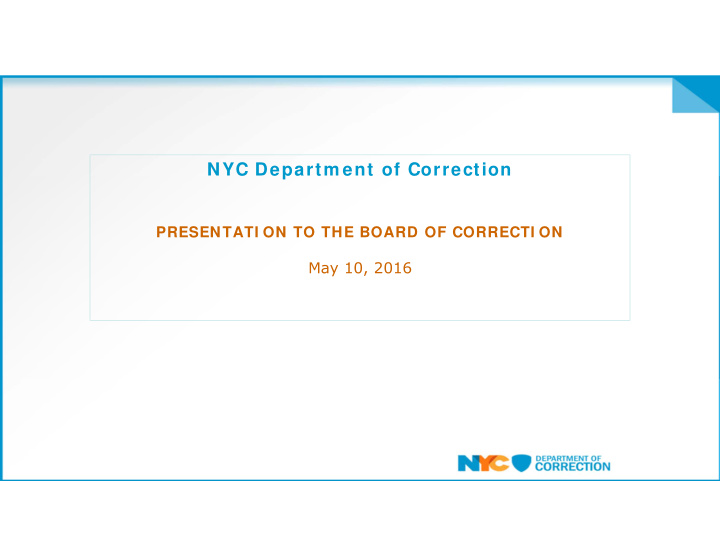



NYC Departm ent of Correction PRESENTATI ON TO THE BOARD OF CORRECTI ON May 10, 2016
Young Adult Plan – Ending Punitive Segregation ▪ DOC is still planning to eliminate punitive segregation for young adults in June 2016 ► Setting a national precedent ► Ongoing, steady, and significant reduction in young adults in punitive segregation ▪ DOC has created programmatic alternatives to punitive segregation to address violence and problematic behavior among this population ► Second Chance and Transitional Restorative Unit (TRU): identical to RNDC’s versions for adolescents ► Secure Unit: new programmatic units for the most persistent and serious violent behavior
Alternatives to Punitive Segregation 38 YAs currently in punitive segregation Following extensive infraction data analysis, DOC will plan for approximately 140 young adults to be housed in alternatives to punitive segregation Second Chance – ~20% 10-12 inmates/unit 2 housing units TRU – ~40% 8-10 inmates/unit 6 housing units Secure Unit – ~40% 8 inmates/unit, depending on behavior 7 housing units
Secure Units - Overview Location – GRVC and OBCC Smaller units will be constructed for Secure Infrastructural alterations and construction ongoing at GRVC (SCOC approved) Staffing and Training High officer to young adult ratio Cognitive-behavioral intervention, Safe Crisis Management, and Direct Supervision Programming Initially, 3 hours of daily programming will include dialectical behavioral therapy, interactive journaling, and individual counseling, with proposed additions of creative writing, art courses, and physical exercise H+H role in placement, treatment, and daily checks Due Process Placement will be adjudicated, with regular reviews and opportunities to appeal and progress Similar to ESH and PHD processes
Secure Units – Most Violent Young Adults New model: programmatic alternative to address the root causes of violence for the most violent, problematic young adults Best practices from DOC alternatives (Second Chance, TRU, ESH) and other jurisdictions (Massachusetts) Like Second Chance and TRU, Treatment Teams will facilitate weekly reviews Treatment plans signed by each YA Pro-social behavior → progressively more incentives Progress through phases (via Treatment Team assessments) based on lack of infractions; compliance with programs in the treatment plan; clean cell and housing units; staff compliance; positive interaction with peers Phased approach successful in ESH Most violent, aggressive young adults Assaults on staff or other inmates resulting in a serious (“A”) injury; slashings/stabbings Persistent, violent behavior that young adult has not addressed in Second Chance and/or TRU
Secure Units – Phased, I ncentivized Approach Phase I Minimum placement of 28 days Lock-out for 10 hours per day Restricted commissary of $10, limited to hygiene products and bottled water One stamped envelope per week Institutional clothing required Personal property limited to one book Phase II Minimum placement of 28 days Lock-out for 12 hours per day Restricted commissary of $15, limited to hygiene products, stationary, and bottled water Institutional clothing required Personal property limited to three books and/or magazines, and family pictures Phase III Minimum placement of 28 days Lock-out for 14 hours per day Commissary spending limited to $25 per week Institutional clothing required Personal property limited to five books and/or magazines, and family pictures
Secure Units – Services and Minim um Standards All required services will be provided Classroom for educational services, law library kiosks, mini-clinics Established practice - currently in place in several other housing units across the Department Recreation Open outdoor yard Minimum Standards Six-month variances requested from BOC Minimum Standards §1- 05(b) “Lock-in” and §1-08(f) “Access to Courts and Legal Services”
Thank You
Recommend
More recommend